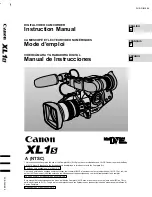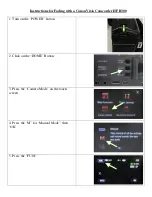
RoboSHOT 12 USB
RoboSHOT 12 USB - Document Number 342-0981 Rev B
Page 9 of 40
Dip Switch Settings Further Explained:
IR 1, 2 and 3 (SW 1 &2):
A single IR remote has the capability of operating up to three
different PTZ cameras in a room. Use these selector DIP switches and the selector
buttons at the top of the IR remote to select the frequency.
IR ON/OFF (SW3):
Turn off the IR reception when only using RS-232 control, Telnet control or controlling the
camera from the web server. The IR is defaulted to ON.
Hint:
Turning off the IR may be confusing to the users
that grab the remote and expect the camera to respond, instead it will seem busted, which is never good.
Image Flip (SW4):
To invert the camera, turn the IMAGE FLIP ON (switch down).
Super-Wide Mode:
Super-wide works only with the RoboSHOT 12 model and allows the camera to switch
from 67.3º wide end HFOV to a Super Wide 73º wide end HFOV.
Baud Rate (SW6):
The options for baud rate are either 9600 or 38,400 bps. The 9600 bps works best with
Cat-5e over distance. Use 38,400 bps for short control lines only.
DIP Switches (SW7 & 8)
: Not used for operation, please leave these DIP switches up or in the OFF position.
Setting the RoboSHOT 12 USB Resolution with the Rotary Switch
For HDMI, set the desired HD resolution with the HDMI VIDEO SELECT rotary switch on the back of the camera.
For USB 3.0 streaming, the Host PC’s OS and conferencing/recording application will negotiate the streaming
resolution. Some applications will the highest possible resolution that the camera and PC can use while others
pick lower resolutions and use the video content as an auxiliary input where the data has priority. Just
remember that the USB resolutions are always negotiated
For the IP Stream (RTSP format with H.264 compression), the resolution is set over the Ethernet network via
the RoboSHOT’s web server on the Streaming menu page.
I
NSTALLATION
B
ASICS
:
The RoboSHOT cameras include a Thin Profile Wall Mount for…wall mounting the camera. There are options for
IN-Wall™ mounts and IN-Ceiling™ Half-Recessed mount as well.
Step 1: Determine Camera Mount Location
When locating the camera, consider viewing angles, lighting conditions, possible
line of site obstructions and check for in-wall or in-ceiling obstructions where the
camera is to be mounted. Always pick a mounting location to optimize the
performance of the camera. Please locate the camera to enable easy positioning
of the camera body with the ability to point down and away from the ceiling and a
pile of fluorescent lighting cells.
Cameras generally don’t like to be swamped with
fluorescent light and nobody sits or stands on the ceiling anyway
.
Step 2:
After determining the optimum location of the camera system, pull and route the required cables from the
camera location back to the PC, network, monitor, switcher or other video destination. The connections can be
routed through the back of the mount, into the wall, or through the bottom of the mount and drop down behind a
monitor to hide the cables. The following connections are available:
a) HDMI Video, which is great for testing if the video is present and troubleshooting USB or IP streaming issues.
Like the example on the previous page, it can be used as a near end (self-view) monitor or for a variety of other
applications.
b) USB 3.0 Streaming Video (UC Conferencing)
c) IP Streaming Video (RTSP format with H.264 compression)
d) DC Power on a 12 VDC, 3 Amp EIAJ-04 Connector
Connect any or all of the video outputs for whatever application is used.
Step 3
: The Thin Profile Wall Mount Bracket’s mounting holes are slotted and are 90° opposing to provide easy
leveling. If mounting to Drywall, hold the mount to the wall and using a level, level it. Mark the center of the slotted
holes. Install the provided wall anchors and attach the mount to the anchors. If the mount is to be mounted on a
2-gang wall box, use the screws supplied with the wall box cover plate to attach Thin Profile Wall Mount Bracket.










































